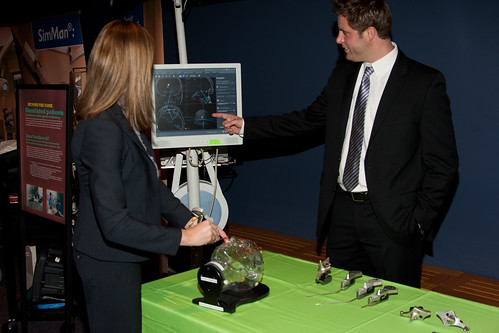 |
| A more steady-handed person than me, practicing brain surgery Orlando Science Center photo |
The simulation industry is big in Central Florida, and the two simulation halls -- Military Tech and Medical Sim City -- take up more floor space than any other part of Otronicon.
I got to try out a simulated brain tumor operation. Using a tool rather like a Wii controller with a knitting needle on the end, I went through the patient’s nose while a computer monitor showed three views of the inside of the head based on the patient’s MRI. I had to find a brain tumor by coordinating the three images simultaneously. Good thing it was a simulator. I am not steady-handed in the best circumstances. The way I stabbed and wiggled, I would have turned a real brain into cervelle de veau.
In the Military Tech hall, I did a better job. An indulgent Lockheed Martin tech gave me some extra time in the multiform simulator, a three-screened, force-feedback behemoth that can be configured to train pilots for many different aircraft. On this occasion, it was an Osprey, that weird hybrid of plane and helicopter.
It was hard to fly, but after a while I got the hang of it. I only crashed three or four times.
Note: if you ever find yourselves at the controls of an Osprey, do not look away for more than a second, no matter how interesting the information is that your trainer is telling you. The Osprey can get away from you quickly, especially if the engines are at an angle.
I had better luck at the ol’ Cessna. Ron, with whom I worked last year, said he wanted a nice, smooth landing.
I did land the Cessna. In the dirt. It wasn’t smooth, but at least it wasn’t a crash.
No comments:
Post a Comment